Patents
Radioactive Vending Machine Tokens
Sometimes vendors would like to sell relatively high-value items in vending machines. That is, merchandise worth more than a candy bar. Nowadays that's not a problem because there's technology that can scan paper currency or read credit cards, making larger transactions possible.But back in the 1960s, vending machines relied on coins for payment, so selling high-value merchandise wasn't practical. Especially since the machines could only measure weight, shape, and size to determine if the coins were real — and these characteristics are easy to fake with low-value blanks.
The British printing company Thomas de la Rue devised a solution: radioactive vending machine tokens.
Its researchers realized it would be possible to create tokens made out of layers of radioactive materials such as uranium and carbon14. These tokens would emit unique radioactive signatures that could be measured by Geiger counters inside a vending machine. Such tokens wouldn't be easy to forge. The company patented this idea in 1967.
I'm not aware that any vending machines accepting radioactive tokens were ever put into to use.
I imagine they would have suffered from the same problem that plagued other efforts to put radiation to practical, everyday use — such as the radioactive golf balls we posted about a few months ago (the radiation made it possible to find the balls if lost). The radiation from one token (or golf ball) wasn't a health hazard, but if a bunch of them were stored together, then the radiation did become a problem.
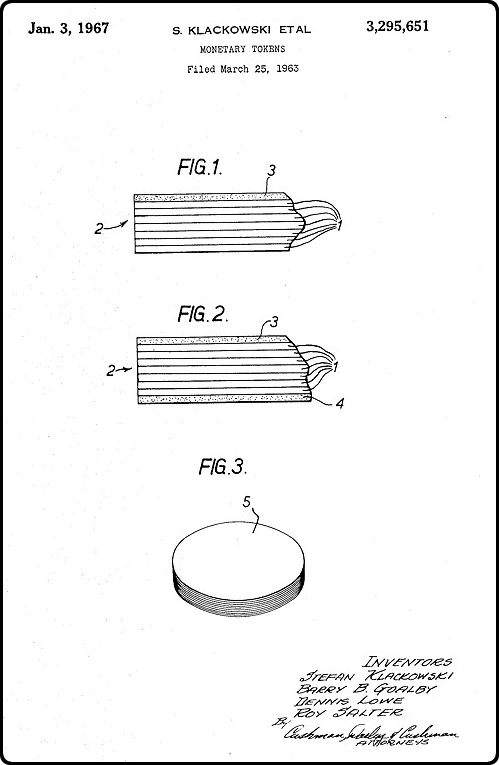
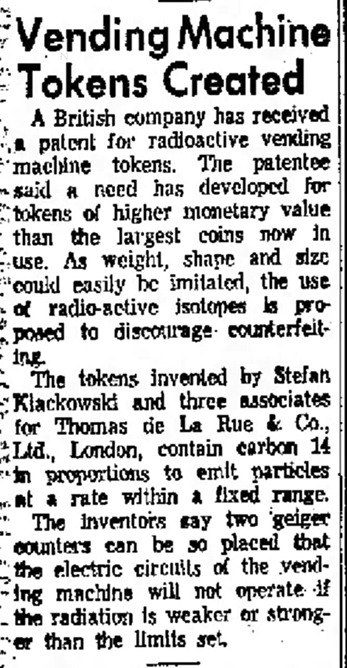
Nashua Telegraph - Jan 11, 1967
Posted By: Alex - Sun Mar 08, 2020 -
Comments (3)
Category: Inventions, Patents, Atomic Power and Other Nuclear Matters, 1960s
Monkey jockeys race greyhounds
In the early 1930s, a new feature was introduced at some greyhound races: monkey jockeys. Apparently the crowds loved the idea. The problem was, the monkeys had trouble staying on the backs of the greyhounds. Animal trainer Rennie Renfro came up with a solution — a special harness that would tie the monkey onto the back of the dog. Renfro patented his invention in 1933.It probably made him some money, because I can find descriptions of races with monkey jockeys for decades afterwards.
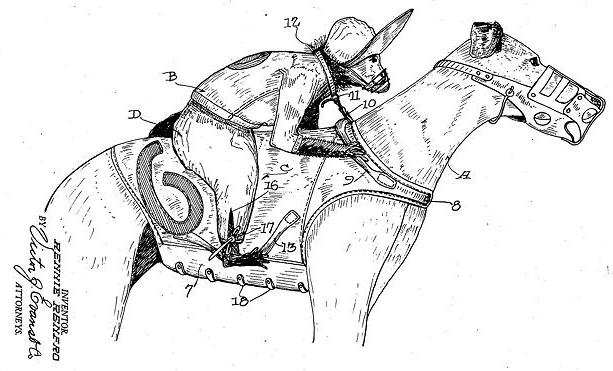
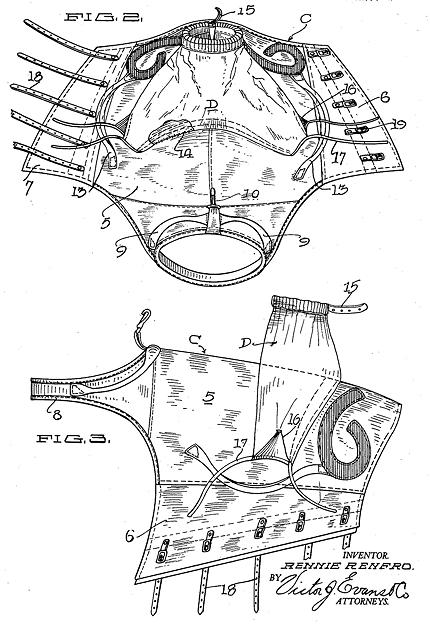
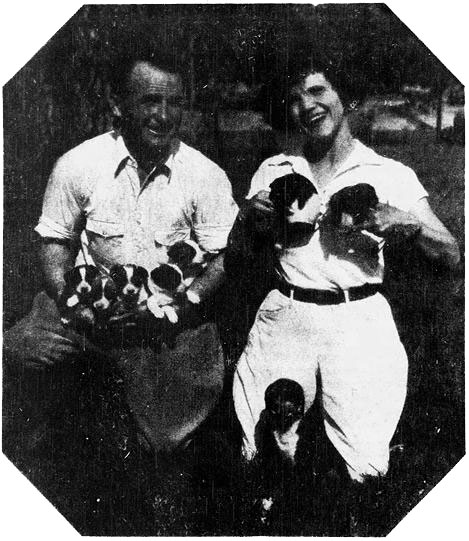
Rennie Renfro (left) and his wife
St. Louis Post Dispatch - July 2, 1933

image source: Greyhound Articles Online
Posted By: Alex - Sun Mar 01, 2020 -
Comments (0)
Category: Inventions, Patents, Sports, 1930s
Airplane Hat
Created by Gilbert Myers of Boise, Idaho. He was evidently worried that someone might steal his idea because, in 1929, he patented it. From the patent:Use of a number of novelty hats constructed as herein disclosed has demonstrated that the hat enjoys the favor of adults as well as children and may be applied to heads of various sizes in a highly convenient and expeditious manner and will remain firmly in place, all without exerting an objectionable pressure on the head.
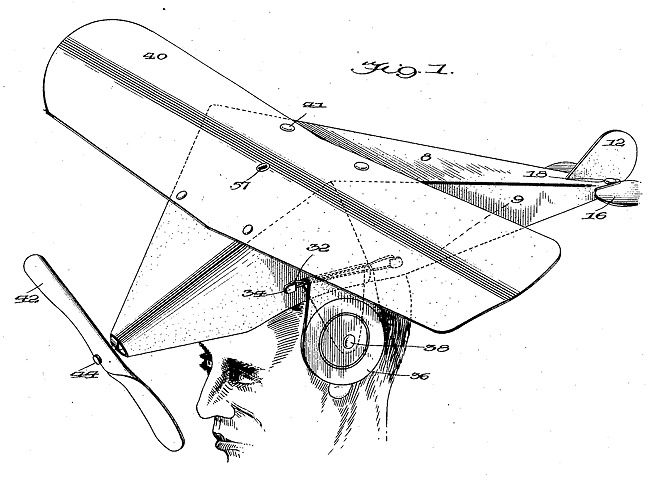
The picture below shows the airplane hat being worn. (The accompanying article identified it as Myers's hat).
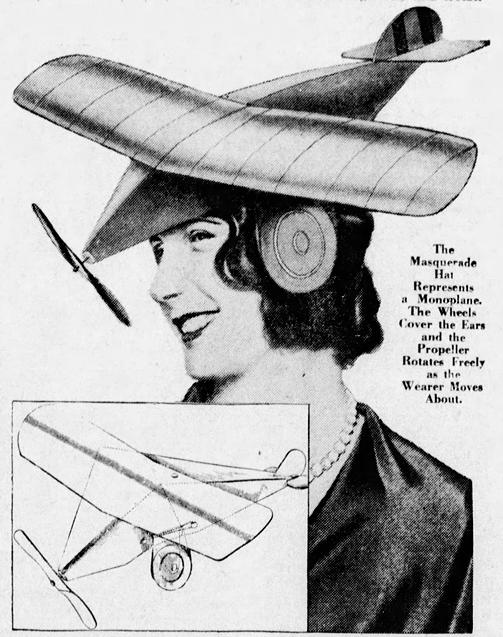
Minneapolis Star Tribune - Feb 2, 1930
These other photos, of actress Alice White, I'm not so sure about. It looks a lot like his hat. If it isn't, someone ignored his patent.


source: Flickr
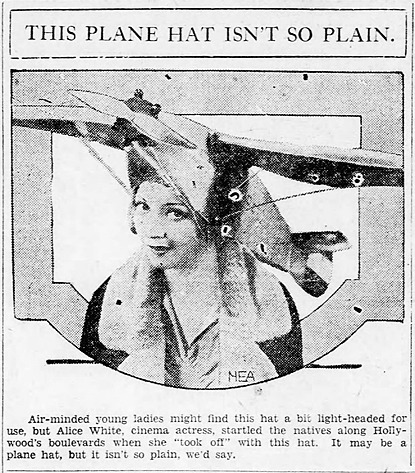
Battle Creek Enquirer - Jan 14, 1930
Posted By: Alex - Sun Feb 23, 2020 -
Comments (2)
Category: Patents, Air Travel and Airlines, Headgear, 1920s
Advertising Chairs
Back in 2018, Paul posted about an "advertising chair" patented in 1910. As a person rocked in it, advertisements scrolled in the armrests.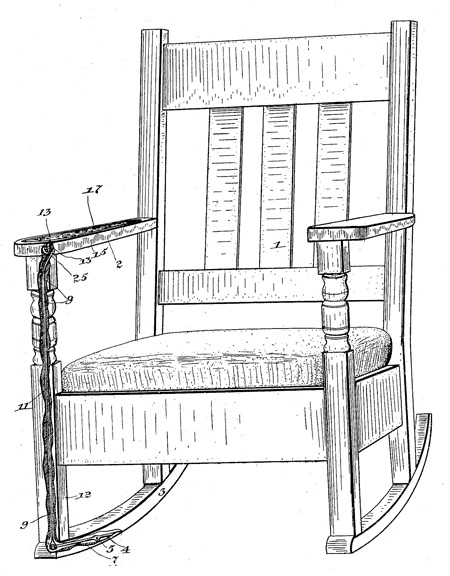
Patent No. 958,793 (1910)
I recently discovered that this invention wasn't a one-off. In the early twentieth century, inventors were actively competing to perfect advertising chairs and inflict them on the public. I was able to find four other advertising chair patents (and there's probably even more than this). To my untrained eye, they all look very similar, but evidently they were different enough to each get their own patent.
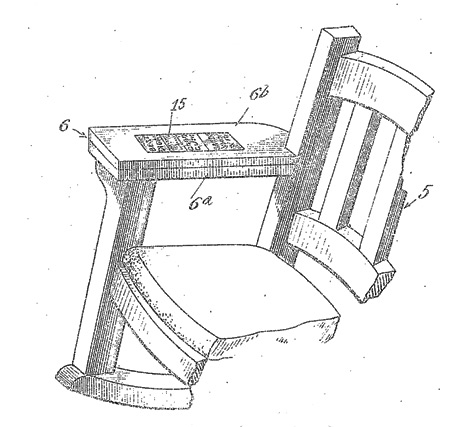
Patent No. 934,856 (1909)
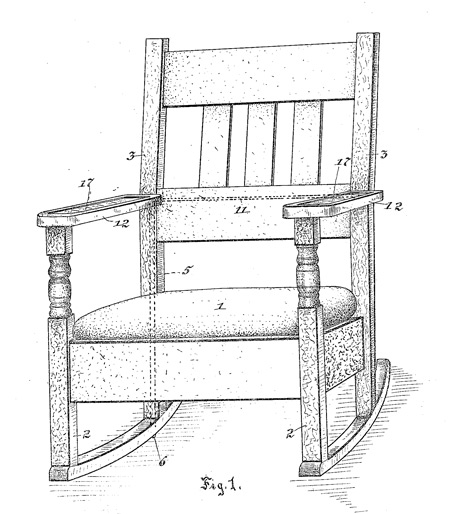
Patent No. 993,397 (1911)
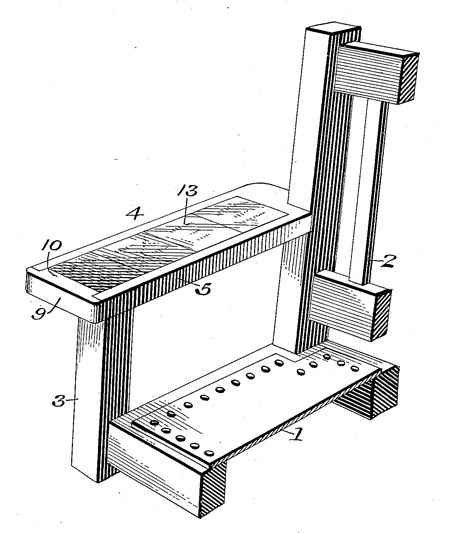
Patent No. 1,094,154 (1914)
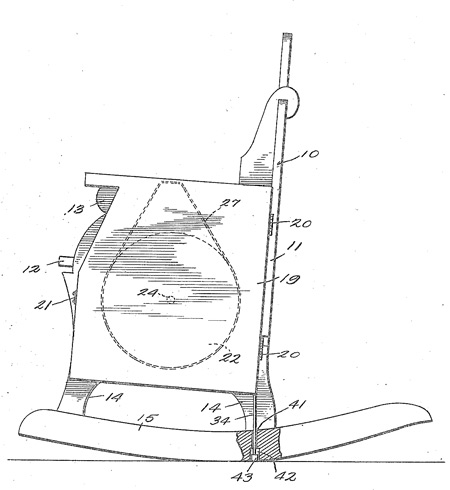
Patent No. 1,441,911 (1923)
A newspaper search brought up an 1895 article that described advertising chairs as the "latest in advertising." It also explained that the concept was to put these chairs in various places where there were captive audiences, such as "hotel lobbies, public libraries, depots and in fact in all places where tired humanity is used to taking a quiet little rest during the day."
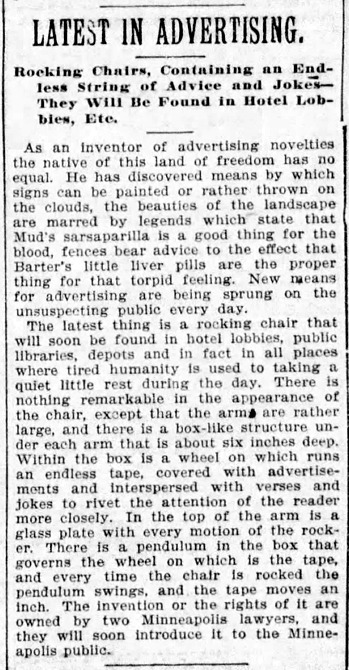
Minneapolis Star Tribune (Dec 8, 1895)
But although entrepreneurs may have been keen to build advertising chairs, the public was evidently far less enthusiastic about them. An editorial in the Kansas City Journal (reprinted in Printer's Ink magazine - Jan 2, 1901) described an advertising chair as "comfortable enough physically, but mentally it is a torture... Just who invented the advertising chair is not known. He has no reason to be proud."
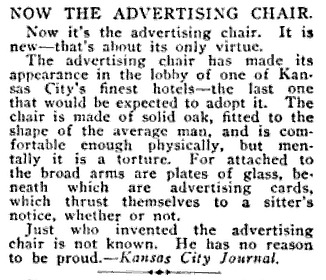
There must have been a number of these advertising chairs in existence, but I'm unable to find any surviving examples of them. Searching eBay, for instance, only pulls up chairs with advertisements printed on them.
Posted By: Alex - Tue Feb 18, 2020 -
Comments (4)
Category: Furniture, Inventions, Patents, Advertising
Shoe Gongs
Anthony Faranda of Yonkers, NY worried that children didn't like wearing rubber-soled shoes because they made no noise when walking on a pavement. So, he invented a shoe gong. Or, as he called it, a "footwear actuated noise maker." He patented it in 1957.It was a disc and clapper that could be worn over shoes. He explained: "The arrangement is such that upon normal walking steps or running strides the clapper is activated to make noise and thereby promote the interest of children in wearing shoes with soles that do not make an audible sound in engaging firm or rigid surfaces."
Maybe kids would have liked these, but not, I imagine, their parents.
He assigned the patent to the NY advertising agency McCann-Erickson. It's unclear what plans they might have had for these things.
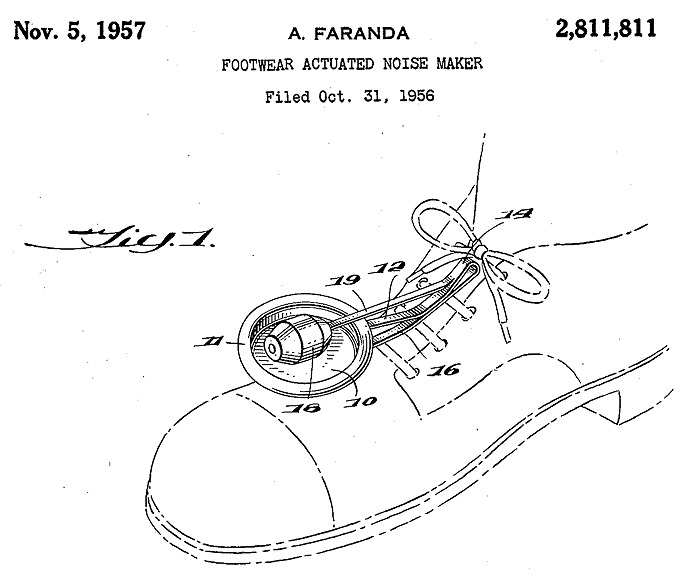
Posted By: Alex - Sun Feb 16, 2020 -
Comments (2)
Category: Inventions, Patents, Shoes, 1950s
Throwing Animals for Taking Death Leaps
Circus proprietor Edward Wulff patented a curious device in 1904. It was an apparatus that catapulted animals upwards. It had the rather alarming title, "Throwing Animals For Taking Death Leaps" (Patent No. 774,017). Wulff claimed it could throw "horses, elephants, monkeys, &c.." The patent illustration shows a horse, so these were evidently the primary animal being thrown.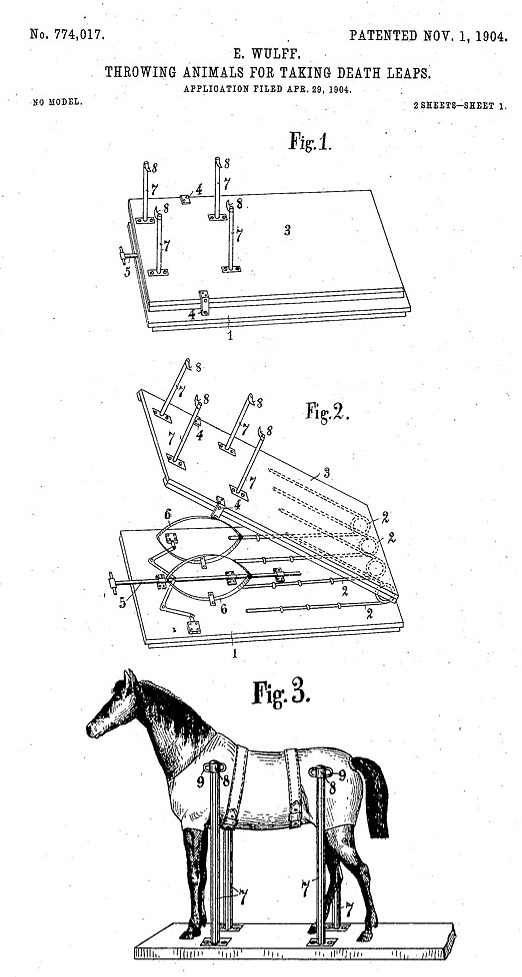
The device was relatively straight-forward. The animals were placed in a harness that held them on top of a spring-powered platform. The release of the springs then flung the animals upwards. Wulff emphasized that his apparatus was designed, via the harness, to place the projecting force on the full body of the animal, rather than just their legs. He seemed to feel that this was a safer, more humane method of throwing animals.
Wulff explained that this device was designed to be used as part of a circus stunt known as "a death leap or so-called 'salto-mortale.'" But he didn't offer any further explanation about the nature of the stunt or how far the animals were flung. And I couldn't locate any descriptions of this stunt in other sources. All the references to a 'death leap' stunt that I came across involved human trapeze artists, not animals. So I was about to conclude that the stunt would have to remain a mystery until I got the idea to check if Wulff had filed the patent in any other countries. Sure enough, there was a British version of the patent, and while its text was almost identical, it had a different title that explained the nature of the stunt:
So Wullf's apparatus was evidently designed to somersault animals. Not simply to catapult them upwards. This made me recall something I posted here on WU back in 2012. It was a brief item that appeared on the front page of the Washington Post's 'Miscellany Section' on April 21, 1907, titled 'Horse Can Turn Somersaults.' At the time, this random reference to a somersaulting horse totally baffled me. I even suspected it was a hoax. But now it makes sense. It must have been a circus stunt. Perhaps it even made use of Wulff's invention. I can't find any evidence that Wulff's circus was in Boston in April 1907, but it was in New York in December of that year.
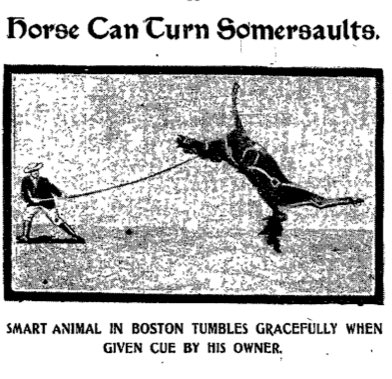
Wulff, it turns out, was the author of another odd patent, granted to him in 1887. The patent was titled, "Means and apparatus for propelling and guiding balloons." He intended to use birds such as "eagles, vultures, condors, &c" to guide balloons. The birds would be attached to the balloon by a harness, and an aeronaut would then force them to fly in the desired direction, thereby propelling the balloon.
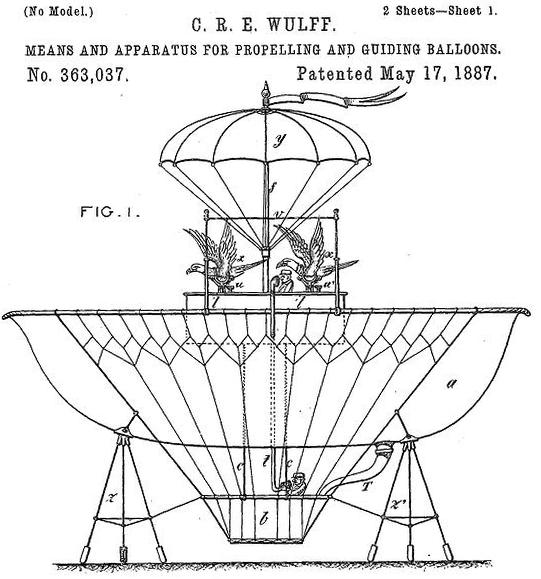
This patent has received quite a bit of attention, because there's a lot of interest in the history of early attempts at flying machines. Knowing that Wulff was a circus proprietor, I wonder if he intended his eagle-guided balloon to be used as part of a circus act, rather than as a practical flying machine.
Posted By: Alex - Sun Feb 09, 2020 -
Comments (6)
Category: Animals, Inventions, Patents, ShowBiz, 1900s
Suntan Suzy Doll
Suntan Suzy was a doll that would develop a tan if you put her in the sunlight. Back in the shade, her tan would fade. She came on the market in 1962, but lasted only one season. As far as I can tell, she was the only doll that has ever had the ability to tan.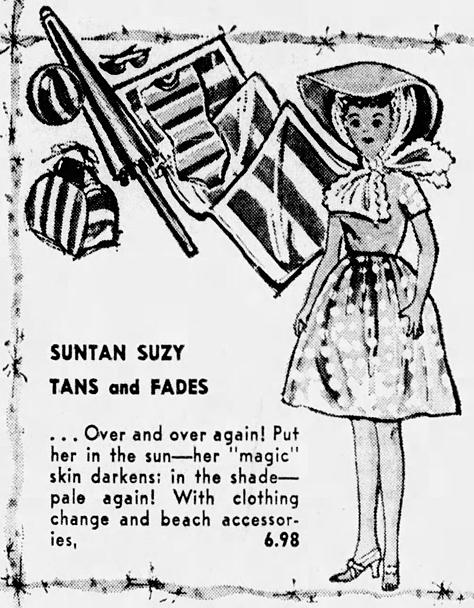
Arizona Republic - Nov 23, 1962

image source: worthpoint
The chemistry responsible for producing the tanning effect is described in Patent No. 2,921,407 (Jan 19, 1960) – “Simulating Sunburning Toy Dolls and Figurines”:
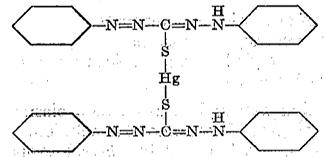
1550 grams of a high molecular weight polyvinyl chloride polymer, in powdered form, were dispersed in this solution by stirring for ten to fifteen minutes. The latter material was specifically Bakelite Company QYNV polymer. Thus a plastisol formulation containing the phototropic dye dissolved in the liquid dioctyl phthalate (plasticizer phase) was obtained. About 120 grams of this plastisol formulation were then poured into a two piece steel mold, this having its inner surface previously coated with a silicone oil release film. This was then placed in an oven at 140 degrees centigrade and held at this temperature for eight minutes to allow solution of the polyvinyl chloride polymer phase. The mold and contents were then removed from the oven, cooled to room temperature, and the now solid form of the doll figure removed.
The figure thus produced was transparent and red in color. Upon exposure to sunlight a progressive darkening to a brown, then blue-black color occurred during a period of about three to four minutes, simulating a “sunburning” effect. When the doll was shielded from the sun a return to the original color took place, being visually complete after a period of eight to ten minutes. This action was repeatable with no detectable change in functional characteristics being noted after several dozen cycles.
It seems like an interesting gimmick for a doll. Curious it never caught on.
Posted By: Alex - Fri Feb 07, 2020 -
Comments (3)
Category: Inventions, Patents, Toys, 1960s
Shave-O-Mat
Harry Thalheim believed that “a need has existed for a long time for a shaving emporium where people may shave cheaply and rapidly at all hours of the day and night.” So, in 1964 he patented the Shave-O-Mat (US Patent No. 3,120,886). It was a coin-operated shave-yourself establishment, open 24 hours a day.Did this address some kind of market need in the 1960s? Were there men who, in the middle of the night, really wanted to shave but couldn’t?
I'm guessing not, because, as far as I can tell, Thalheim's Shave-O-Mat never opened.
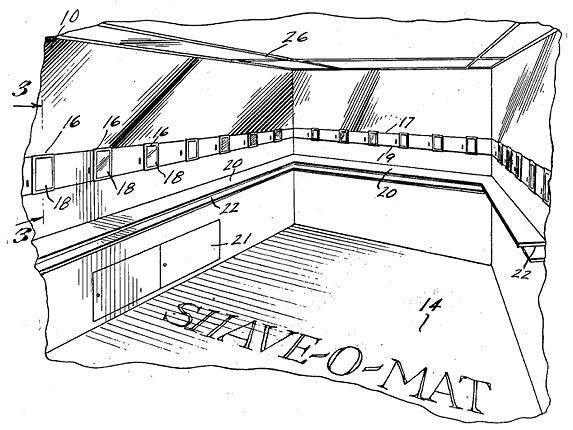
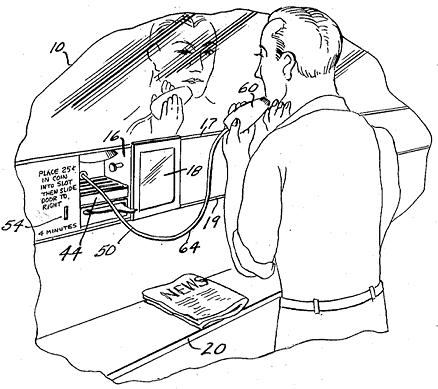
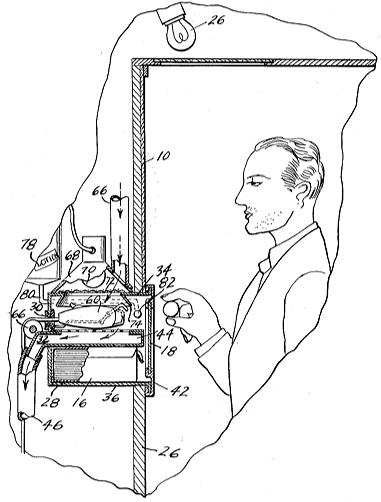
Posted By: Alex - Sun Feb 02, 2020 -
Comments (0)
Category: Inventions, Patents, 1960s, Hair and Hairstyling
Diapers with pistol holsters
Patented by Harriet Y. Clough of Meadville, Pennsylvania in 1958.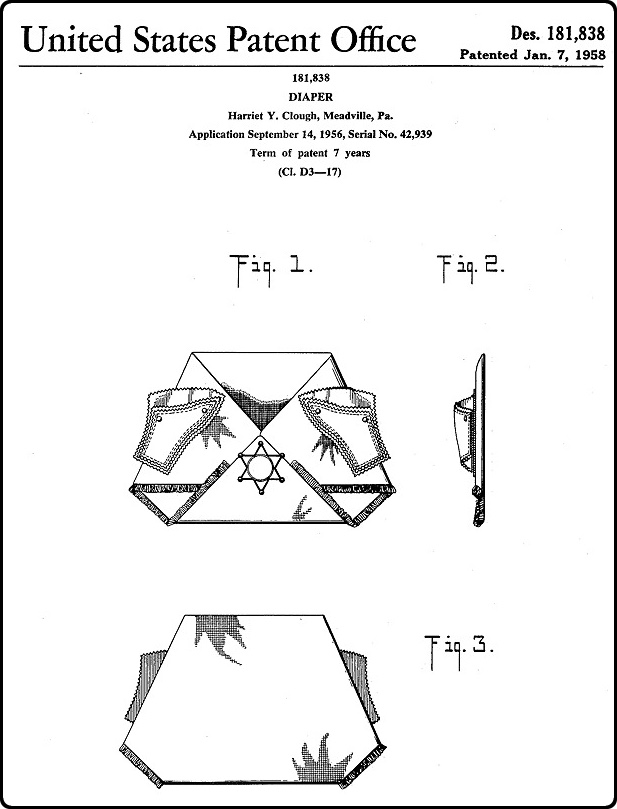
Posted By: Alex - Sun Jan 26, 2020 -
Comments (0)
Category: Babies, Guns, Inventions, Patents
The Beautiful Beauty Mask
Patented in 1954 by Ann S.V. Mann of Petersburg, Virginia.It functioned like any other beauty mask. Its primary difference, claimed Mann, was that her mask had the outer appearance of a "strikingly beautiful woman":
The exterior surface of the plastic film body 5 is painted or otherwise decorated to create eyebrows, lashes, nose and mouth lines, etc., so designed as to give the facial appearance of a strikingly beautiful woman. This artistic treatment is an important feature of the invention. Beauty is accentuated in every way possible in all phases of the invention.
Due to the uncanny valley effect, she may actually have ended up creating something that looked more grotesque than a regular mask.
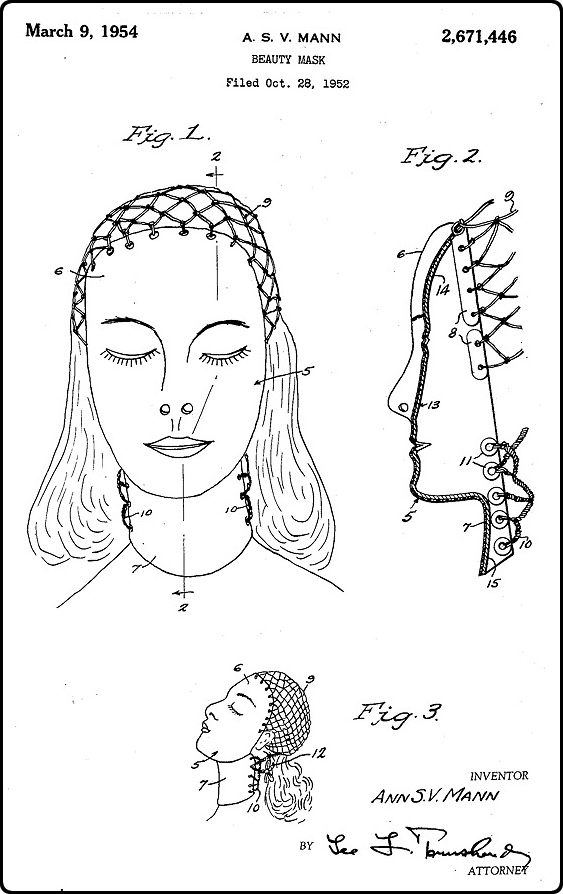
Posted By: Alex - Sun Jan 19, 2020 -
Comments (2)
Category: Beauty, Ugliness and Other Aesthetic Issues, Inventions, Patents, 1950s

| Who We Are |
|---|
| Alex Boese Alex is the creator and curator of the Museum of Hoaxes. He's also the author of various weird, non-fiction, science-themed books such as Elephants on Acid and Psychedelic Apes. Paul Di Filippo Paul has been paid to put weird ideas into fictional form for over thirty years, in his career as a noted science fiction writer. He has recently begun blogging on many curious topics with three fellow writers at The Inferior 4+1. Contact Us |




